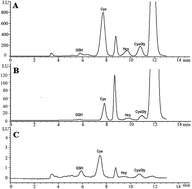Determination of total, free, and reduced homocysteine and related aminothiols in uremic patients undergoing hemodialysis by precolumn derivatization HPLC with fluorescence detection
Abstract
Homocysteine (Hcy) and its metabolically related aminothiols cysteine (Cys), cysteinylglycine (CysGly), and glutathione (GSH) play important roles in the pathogenesis of uremia. Most of these aminothiols exist in plasma as disulphide and mixed disulphide forms. A new, simple, sensitive and reliable precolumn derivatization HPLC method, with fluorescence detection, for the determination of four kinds of aminothiols, including total, free and reduced fractions, in plasma simultaneously was established and validated. After a simple derivatization using N-(1-pyrenyl) maleimide (NPM), the assay was performed using a C-18 column with gradient elution. The method used for the total aminothiol determinations was linear in the range of 2.00–80.0, 10.0–1500, 1.00–120, and 3.00–240 μmol L−1 for GSH, Cys, Hcy, and CysGly, respectively. The method used for the reduced aminothiols was linear in the range of 0.10–8.00, 1.25–50.0, 1.25–50.0, and 0.01–4.00 μmol L−1 for GSH, Cys, Hcy, and CysGly, respectively. The method was successfully applied to the analysis of plasma from uremic patients (n = 29) and healthy subjects (n = 28). The results showed that the concentrations of the total, free and reduced forms of Hcy, Cys and CysGly were higher, while the concentrations of the three forms of GSH were lower (p < 0.05) in uremic patients than in the healthy controls. The concentrations of the three forms of Hcy and Cys were significantly decreased, but the concentrations of the three fractions of GSH and CysGly had no significant change, during hemodialysis. In conclusion, the developed method is simple, fast, accurate, and suitable for clinical measurements.


 Please wait while we load your content...
Please wait while we load your content...